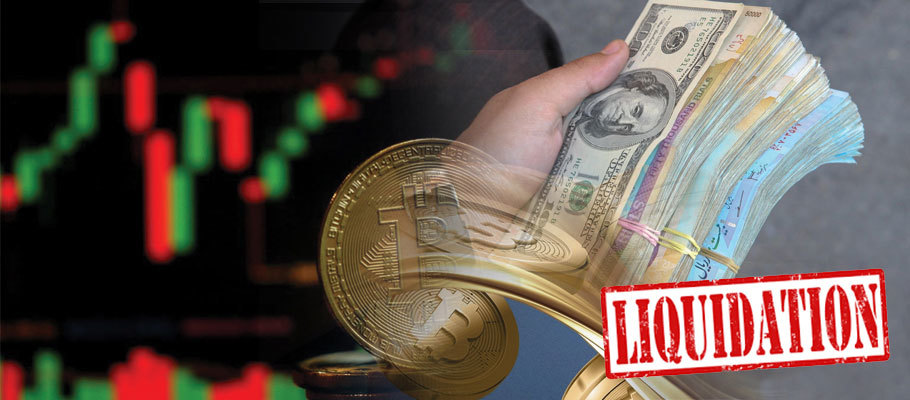
Published: September 24th, 2021
More than USD 1.1 billion in cryptocurrency futures were liquidated in a single day this week as global markets slid in almost every asset category.
It was a week when most of the top cryptocurrencies fell sharply into the red. At the time of writing, bitcoin was down 12 per cent from last Saturday, while ethereum, the second-largest crypto by market cap, also lost 12 per cent.
According to figures from blockchain analytics platform Bybt, the sudden return to bear markets triggered a torrent of liquidations on crypto derivatives trading platforms.
This can happen in periods of volatility. If a position is overleveraged and the price of the underlying asset dips sharply, a margin call is issued, and the trade is automatically liquidated if the trader can’t meet the margin requirement.
Long trading positions naturally accounted for most of the week’s liquidations. Bybt says 83 per cent of liquidated positions were long bets assuming that prices would rise.
More than 200,000 traders lost their positions through the week’s session. The biggest single liquidation was valued at USD 10 million and happened on the BitMEX crypto exchange.
It isn’t just crypto markets that have stumbled this week; stock indices, including the Dow Jones Industrial Average, the S&P 500, plus global equity markets generally, felt the pain.
Most analysts are blaming the global market meltdown on concerns swirling around heavily indebted Chinese property giant Evergrande. According to Reuters, the looming collapse of the debt-laden real estate giant could impact the entire global economy.
Analyst James Chang of Rockefeller Global Family Office told Reuters that the company ‘is systemically important. 'If a collapse of the business affected growth prospects in China, the rest of the global economy would feel the contagion.’
Global equity markets were on high alert all week as the business faced a critical test of its solvency: interest payments worth USD 83 million on its bonds.
At the start of the week, the company began to offer investors in its wealth management business property in lieu of cash payment. On Thursday, an 11th hour deal with the Chinese central bank to inject cash into the banking system temporarily calmed fears of imminent collapse.
The company was founded in 1996 by entrepreneur Hui Ka Yan in Guangzhou, southern China. Today it owns or has the controlling interest in more than 1,300 properties and construction projects across 280 cities in China.
Parent company Evergrande Group has branched out far beyond property. Its interests range from electric cars to food and beverage manufacturing and wealth management. It owns Guangzhou FC, one of China’s biggest football teams.
Hui’s vast fortune made him Asia's wealthiest person in 2019 and 2020. His net worth has dropped significantly in recent months. However, Forbes still pegs his current fortune at more than USD 10 billion.
Evergrande became one of China's most prominent companies, in part by borrowing heavily, rapidly taking on debts of more than USD 300 billion.
Worried about the company’s ballooning debt-load and the potential for others to follow suit, Beijing enacted new rules last year to limit the amount big real estate developers can borrow.
The new rules led Evergrande to sell many properties at fire-sale prices in order to keep enough cash to hand. This week it’s in crisis, struggling to meet the interest on its 170-plus loans and other debt obligations.
The business’s cash flow situation has cratered Evergrande's share price by 85 per cent in the past six months, while credit rating agencies have downgraded its corporate bonds.
A collapse of Evergrande could wipe out the finances of thousands of people who paid for properties before building work began. Then there is the broader ecosystem of engineering, construction, architecture firms, and component suppliers, all now at risk of losing critical income or seeing large invoices go unpaid, potentially forcing some into bankruptcy.
However, the potential impact on China's financial system is a potential game-changer for crypto and forex traders.
This week, the Economist Intelligence Unit wrote that the financial fallout from an Evergrande collapse ‘would be far reaching’.
‘The business reportedly owes money to 170 or more large domestic banks and 120 other financial institutions. A default could force the creditor banks and other lenders to reign in borrowing elsewhere, leaving less liquidity in global markets for investment, R&D, and growth.
The result would be a classic ‘credit crunch’, where firms struggle to obtain credit at affordable rates.
That would be a horrible result for the world's second-largest economy and could also put a chill on foreign investment if China is seen as a less attractive place to place bets on growth.
As the reality of Evergrande’s situation unfolded this week, the yuan dipped to its lowest point in three weeks on Wednesday, pulling other risk and commodity currencies down with it. The dollar was seen as a safe haven and rose as the risk-off sentiment grew more palpable.
That was a notable turnaround from the previous week, when the yuan tipped above 6.4266 per dollar, its highest level in three months. The sharp slump seen this week came after Chinese regulators first that Evergrande's situation was perilous and needed to be stabilised fast.
Yuan dropped to 6.4681 per dollar. Evergrande spillover also pulled the New Zealand and Australian dollars down to levels at or close to three-week lows.
The yen experienced a boost of 0.2 per cent to reach 109.69 yen per dollar. The pound fell 0.5 per cent to touch a four-week low of USD 1.3659.
The greenback had risen by 0.2 per cent at mid-week. Across the pond, the euro fell 0.15 per cent lower at USD 1.1705.